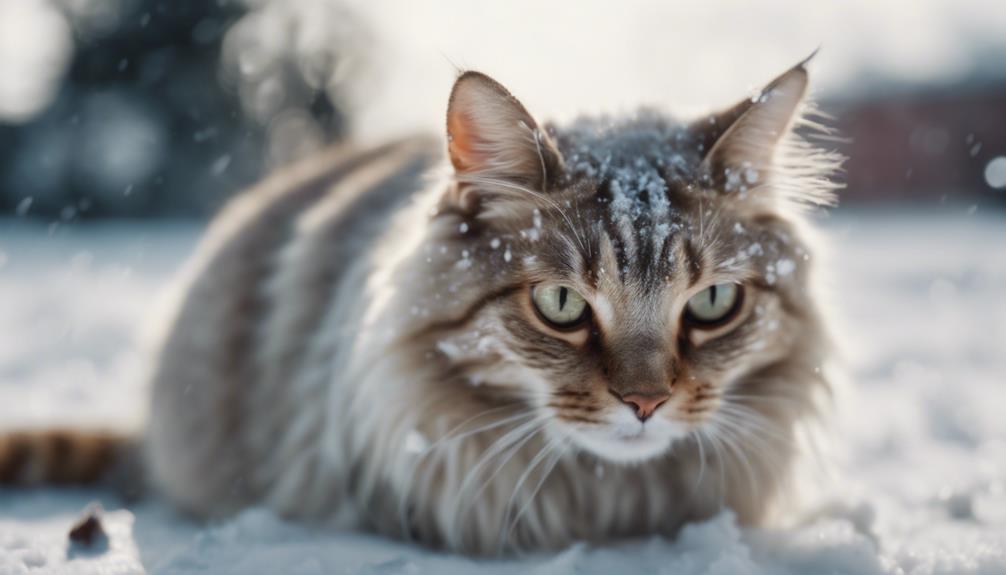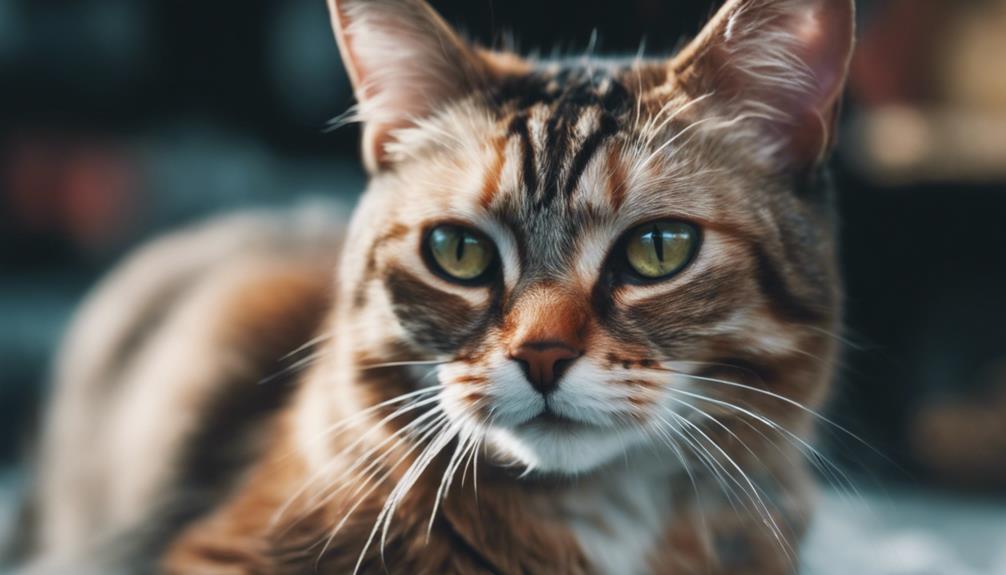When it comes to safeguarding our feline companions from the perils of frostbite, awareness and preparedness are key. Recognizing the subtle signs that may indicate frostbite in cats is crucial for prompt intervention.
However, the treatment and prevention strategies go beyond mere observation. By understanding the nuances of frostbite in cats and the tailored care required, pet owners can navigate this chilling threat effectively.
Stay tuned to uncover the essential steps to recognize, treat, and prevent frostbite in cats, ensuring the well-being of our beloved feline friends in the face of winter's icy grip.
Key Takeaways
- Frostbite in cats affects small body parts like ears and paws, with severity varying from mild to severe.
- Signs include cold, pale, or blue areas, progressing to black indicating dead tissue.
- Veterinary treatment is crucial, including warming, avoiding rubbing, and possible surgical intervention.
- Prevention involves keeping cats indoors during extreme cold, using winter gear, and providing outdoor shelters.
Understanding Frostbite in Cats
Understanding the dangers of frostbite in cats is crucial for pet owners to protect their feline companions during cold and harsh weather conditions. Cats, especially those with short hair or no hair, are susceptible to frostbite, primarily affecting smaller body parts like ear tips, tails, and paws. Severity can range from mild to severe, with wet and windy conditions posing higher risks.
It's essential to be mindful of kittens, senior cats, and those with underlying health issues as they are more vulnerable. Recognizing the risks and taking preventive measures such as keeping cats indoors during extreme weather can help mitigate potential frostbite issues in our beloved feline friends.
Signs and Symptoms of Frostbite
Recognizing the signs and symptoms of frostbite in cats is essential for pet owners to promptly identify potential issues and seek appropriate veterinary care. Frostbite occurs at temperatures at or below freezing and can range from mild to severe. Mild frostbite may present as feeling cold, pale, or blue and can often recover with warming. However, severe frostbite appears blue and may progress to black, indicating dead tissue that may require surgical amputation. Look out for signs of pus or a foul odor, which can develop during tissue sloughing. To help you recognize frostbite more easily, here is a table summarizing the signs and symptoms:
| Signs and Symptoms of Frostbite | |
|---|---|
| Mild Frostbite | – Feeling cold, pale, or blue |
| Severe Frostbite | – Blue or black tissue, potential for amputation |
| Tissue Sloughing | – Pus or foul odor |
Treatment of Frostbite in Cats

When treating frostbite in cats, prompt veterinary intervention is essential to ensure proper care and recovery. Move the cat to a warm, dry location, avoiding rubbing frostbitten areas.
Apply gentle warmth with warm water or compress indoors. Only a vet can decide if surgical intervention is necessary. Pain medication and antibiotics may be prescribed by the vet to aid in recovery.
It's crucial to follow the vet's instructions diligently and monitor the cat's progress closely. Remember, early and appropriate treatment is key to preventing complications and promoting healing.
Frostbite Severity and Vulnerability Factors
Factors influencing the severity of frostbite in cats include environmental conditions, breed characteristics, and the age and health status of the feline. Cats exposed to wet and windy conditions are at higher risk of severe frostbite. Additionally, hairless and short-haired breeds, such as the Sphynx or Siamese, are more vulnerable compared to long-haired breeds like the Persian.
Young kittens and senior cats with underlying health issues are also at increased risk. Understanding these vulnerability factors can help cat owners take proactive measures to protect their feline companions from the dangers of frostbite.
Importance of Veterinary Treatment

Understanding the significance of prompt veterinary treatment is crucial in safeguarding cats from the detrimental effects of frostbite, emphasizing the need for immediate professional intervention to mitigate potential complications and ensure optimal recovery outcomes. Seeking veterinary care promptly can make a significant difference in the cat's prognosis and overall well-being. Veterinarians are equipped to assess the extent of frostbite damage, provide appropriate pain management, administer necessary medications, and determine if surgical intervention is required. Below is a table summarizing the key reasons why veterinary treatment is essential in cases of feline frostbite:
| Importance of Veterinary Treatment in Frostbite |
|---|
| 1. Immediate assessment of frostbite severity |
| 2. Administration of pain relief and antibiotics |
| 3. Potential need for surgical intervention |
Preventing Frostbite in Cats
To safeguard cats from frostbite, proactive measures should be taken to prevent exposure to extreme cold conditions.
- Keep Cats Indoors: Ensure that your feline companion remains indoors during harsh weather to avoid frostbite risks.
- Provide Winter Gear: If your cat enjoys outdoor activities, consider dressing them in winter gear or applying paw balm to protect their paws.
- Offer Shelter Options: Set up outdoor cat houses or provide warm blankets in pet strollers for cats that dislike clothing, ensuring they have a cozy retreat during winter outings.
Recognizing Mild Vs. Severe Frostbite

Distinguishing between mild and severe frostbite in cats is crucial for prompt and appropriate medical intervention. Mild frostbite in cats may present with symptoms like feeling cold, pale, or blue in the affected areas. These mild cases can often be managed effectively with warming techniques.
On the other hand, severe frostbite is characterized by a more intense bluish discoloration that may progress to black, indicating tissue death. In severe cases, surgical intervention might be necessary to remove dead tissue and prevent further complications.
It's important for cat owners to monitor their pets closely in cold weather conditions and seek veterinary care promptly if they suspect frostbite, as early recognition can significantly impact the outcome.
Surgical Intervention for Frostbite
Surgical intervention for frostbite in cats may be necessary in severe cases to address tissue damage and prevent further complications. When considering surgical options for frostbite in cats:
- Debridement: Surgical removal of dead or damaged tissue is crucial to prevent infection and promote healing.
- Amputation: In cases of severe frostbite where tissue necrosis is extensive, amputation of affected body parts may be necessary to save the cat's life.
- Skin Grafting: Skin grafts may be performed to cover large areas of tissue loss, aiding in the regeneration of healthy skin and tissue.
These surgical interventions are aimed at improving the cat's quality of life and preventing the spread of infection resulting from severe frostbite.
Management and Recovery Strategies

When addressing the management and recovery of frostbite in cats, it is imperative to implement comprehensive care strategies that prioritize both healing and prevention of complications.
After veterinary assessment and initial treatment, ongoing monitoring for signs of infection, tissue necrosis, or circulation issues is crucial. Keep the affected areas clean and dry, and follow all medication and care instructions provided by the veterinarian diligently.
Provide a warm and comfortable environment for your cat to aid in their recovery process. Regular check-ups with the vet are recommended to track progress and address any emerging issues promptly.
Winter Safety Tips for Cats
During the winter months, ensuring the safety of your feline companion requires proactive measures and thoughtful considerations. Here are some winter safety tips to keep your cat warm and secure:
- Indoor Sanctuary: Provide a cozy indoor environment during extreme cold spells, ensuring your cat's comfort and safety.
- Winter Gear: Consider dressing your cat in winter gear or using paw balm to protect their sensitive paws during outdoor excursions in the snow.
- Shelter Solutions: Set up outdoor cat houses or provide pet strollers with blankets for free-roaming cats to seek refuge from the cold and stay warm.
Frequently Asked Questions
Can Frostbite in Cats Lead to Long-Term Health Issues or Complications?
Frostbite in cats can lead to long-term health issues or complications if not promptly addressed. Severe cases may result in tissue death, requiring surgical intervention. Veterinary treatment, including pain management and antibiotics, is crucial for optimal recovery.
Are There Any Specific Breeds of Cats That Are More Prone to Frostbite Than Others?
Certain cat breeds, like hairless or short-haired ones, are more susceptible to frostbite due to their reduced insulation. Breeds such as Sphynx or Siamese require extra protection in cold weather to prevent frostbite complications.
How Quickly Should a Cat With Suspected Frostbite Be Taken to the Vet for Treatment?
If a cat is suspected to have frostbite, immediate veterinary evaluation is crucial. Timely treatment can prevent complications and minimize tissue damage. Don't delay; seek professional care promptly to ensure the best outcome for the cat's health.
Are There Any Home Remedies or First Aid Measures That Can Be Taken for Frostbite in Cats Before Seeking Veterinary Care?
While seeking veterinary care is crucial for frostbite in cats, initial steps like moving the cat to a warm area, avoiding rubbing the affected areas, and gently applying warm compresses indoors can help before professional intervention.
What Are Some Potential Risks or Dangers Associated With Untreated Frostbite in Cats?
Untreated frostbite in cats can lead to tissue damage, infection, and possible limb loss. Severe cases may progress to gangrene, posing life-threatening risks. Immediate veterinary attention is crucial to prevent long-term complications and ensure the cat's well-being.
Conclusion
In conclusion, recognizing, treating, and preventing frostbite in cats is essential for ensuring their well-being, especially in colder climates.
By understanding the signs and symptoms, seeking appropriate veterinary treatment, and implementing proactive prevention measures, cat owners can effectively navigate the challenges posed by frostbite.
With comprehensive knowledge and proactive care, feline companions can be safeguarded from this chilling affliction during winter months.




